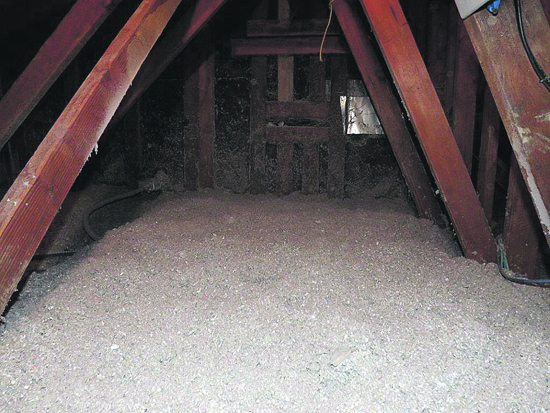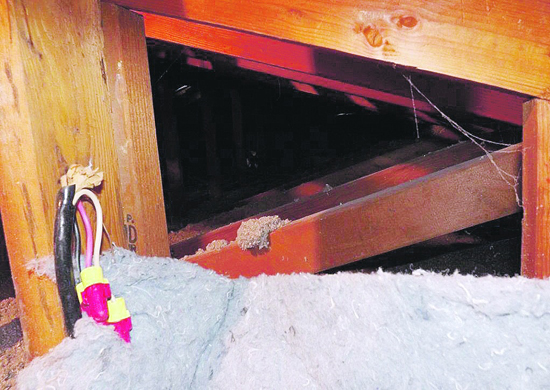 | | | Replaced new insulation Photos Cathy Dausman
| | | | | | Your Lamorinda house may be warm in the winter, and comfortably cool in the summer, but paying utility bills to keep it that way can make you hot under the collar.
 The U.S. Department of Energy (DOE) says heating and cooling accounts for up to 70 percent of the energy use in your home. Maybe it's time to consider an insulation upgrade?
The U.S. Department of Energy (DOE) says heating and cooling accounts for up to 70 percent of the energy use in your home. Maybe it's time to consider an insulation upgrade?
 Home insulation may be found in attics, walls or crawl spaces, but when considering attic insulation you first need a physics lesson: heat flows from warm to cool. (You probably already knew that, since in winter you try to corral the warm air inside.) During summer, mid-day sun wants in, and tends to heat up the house. Insulation slows or prevents such unwanted changes.
Home insulation may be found in attics, walls or crawl spaces, but when considering attic insulation you first need a physics lesson: heat flows from warm to cool. (You probably already knew that, since in winter you try to corral the warm air inside.) During summer, mid-day sun wants in, and tends to heat up the house. Insulation slows or prevents such unwanted changes.
 Insulation is rated in terms of heat, or thermal resistance, and is expressed in R-value (the more insulation the greater the R-value). R-value is found by multiplying thickness in inches by a number from 2.5 to 3.7 (based on insulation type). Fiberglass fiber has the lowest R-value, and cellulose (newsprint) the highest. If your attic has yellow, pink or white rolls or batts, it's likely fiberglass. Loose fibers in light colors are probably fiberglass, and darker colored fibers could be rock wool. If you're seeing light-weight granules, that might be vermiculite or perlite.
Insulation is rated in terms of heat, or thermal resistance, and is expressed in R-value (the more insulation the greater the R-value). R-value is found by multiplying thickness in inches by a number from 2.5 to 3.7 (based on insulation type). Fiberglass fiber has the lowest R-value, and cellulose (newsprint) the highest. If your attic has yellow, pink or white rolls or batts, it's likely fiberglass. Loose fibers in light colors are probably fiberglass, and darker colored fibers could be rock wool. If you're seeing light-weight granules, that might be vermiculite or perlite.
 It's possible to "beef up" your R-value simply by adding on to existing insulation; just be sure not to compress the old layer. Insulation works much like a down comforter; it's as much the air pockets as the material itself that holds in the heat.
It's possible to "beef up" your R-value simply by adding on to existing insulation; just be sure not to compress the old layer. Insulation works much like a down comforter; it's as much the air pockets as the material itself that holds in the heat.
 If you decide to install new insulation yourself, you will likely be working with rolls. Wear protective long-sleeved clothing, plus a hat, goggles, gloves and respirator. Leave space around bare stove pipes, electrical fixtures, motors or recessed light fixtures to prevent fire. It's especially dangerous to pack insulation onto electrical nob and tube wiring (found in houses built before 1940).
If you decide to install new insulation yourself, you will likely be working with rolls. Wear protective long-sleeved clothing, plus a hat, goggles, gloves and respirator. Leave space around bare stove pipes, electrical fixtures, motors or recessed light fixtures to prevent fire. It's especially dangerous to pack insulation onto electrical nob and tube wiring (found in houses built before 1940).
 If you hire a contractor, your insulation can be rolled or blown in. Be sure to get several estimates and always ask for the same R-value, to compare apples to apples. A contractor will even completely remove old insulation and install all new, although that costs more.
If you hire a contractor, your insulation can be rolled or blown in. Be sure to get several estimates and always ask for the same R-value, to compare apples to apples. A contractor will even completely remove old insulation and install all new, although that costs more.
 Forty years ago, fiberglass was commonly used for attic insulation; now recycled cellulose fiber made from newsprint is available. Cellulose insulation is non-toxic, a borate treatment makes it fireproof, and rodents won't nest in it (as they will in fiberglass).
Forty years ago, fiberglass was commonly used for attic insulation; now recycled cellulose fiber made from newsprint is available. Cellulose insulation is non-toxic, a borate treatment makes it fireproof, and rodents won't nest in it (as they will in fiberglass).
 Pacific Gas and Electric offers a 15-cent per square foot energy rebate to residential customers on some insulation upgrades through Dec. 31. Go to www.pge.com/rebates for details. The DOE website http://www.ornl.gov/~roofs/Zip/ZipHome.html offers insulation guidelines by zip code (although the Lamorinda area zip codes entered default to Napa, Calif.). A full fact sheet is available online at http://www.ornl.gov/sci/roofs+walls/insulation/ins_01.html.
Pacific Gas and Electric offers a 15-cent per square foot energy rebate to residential customers on some insulation upgrades through Dec. 31. Go to www.pge.com/rebates for details. The DOE website http://www.ornl.gov/~roofs/Zip/ZipHome.html offers insulation guidelines by zip code (although the Lamorinda area zip codes entered default to Napa, Calif.). A full fact sheet is available online at http://www.ornl.gov/sci/roofs+walls/insulation/ins_01.html.

|

